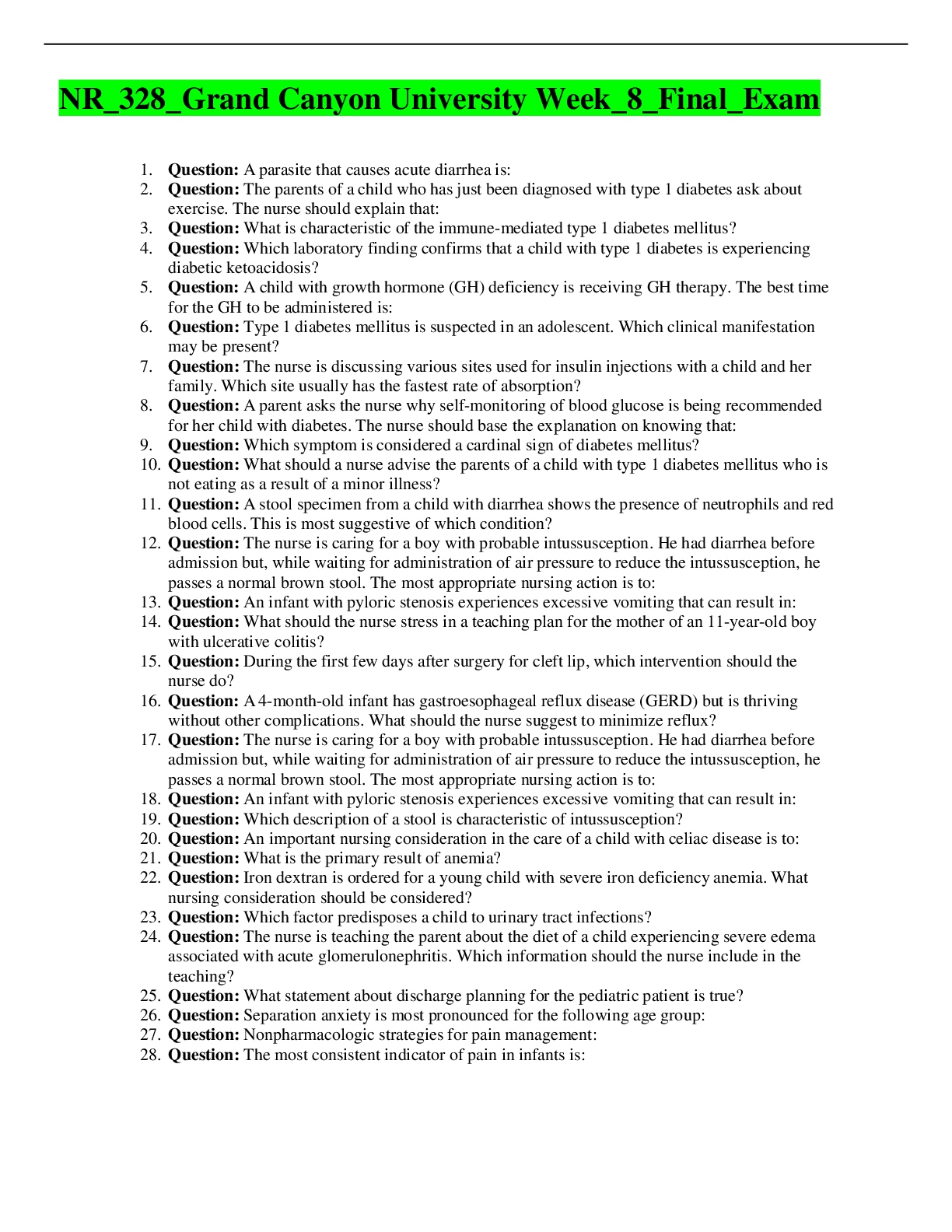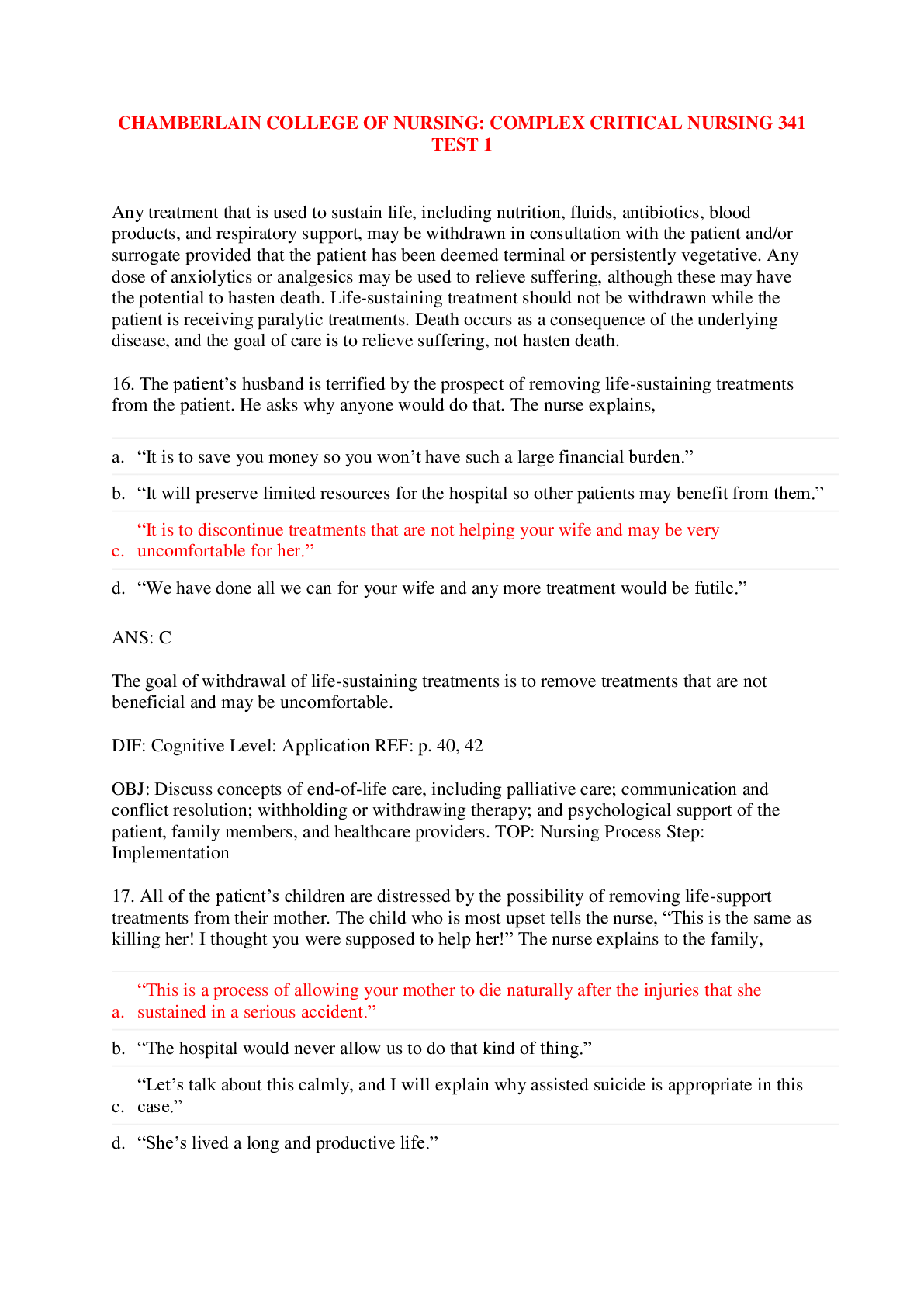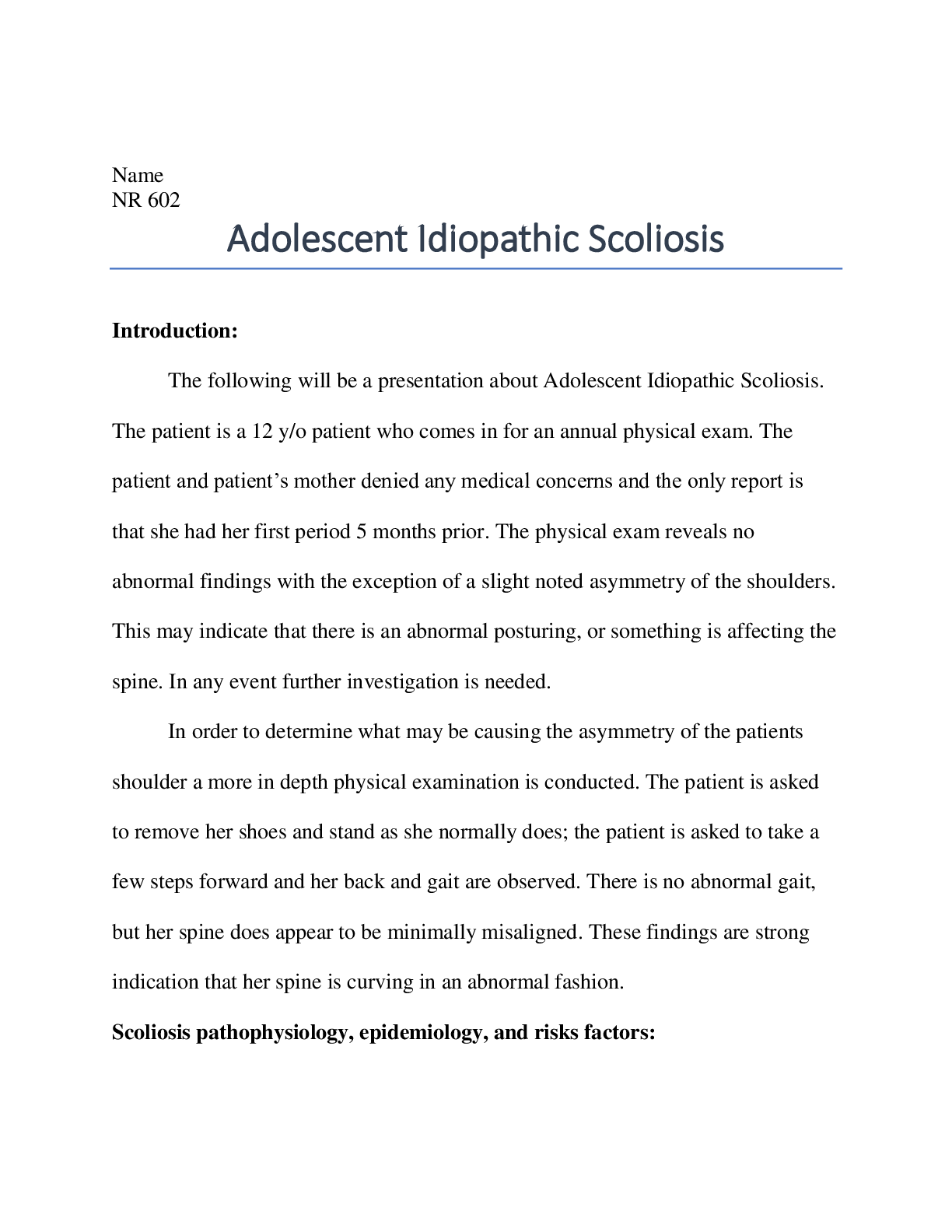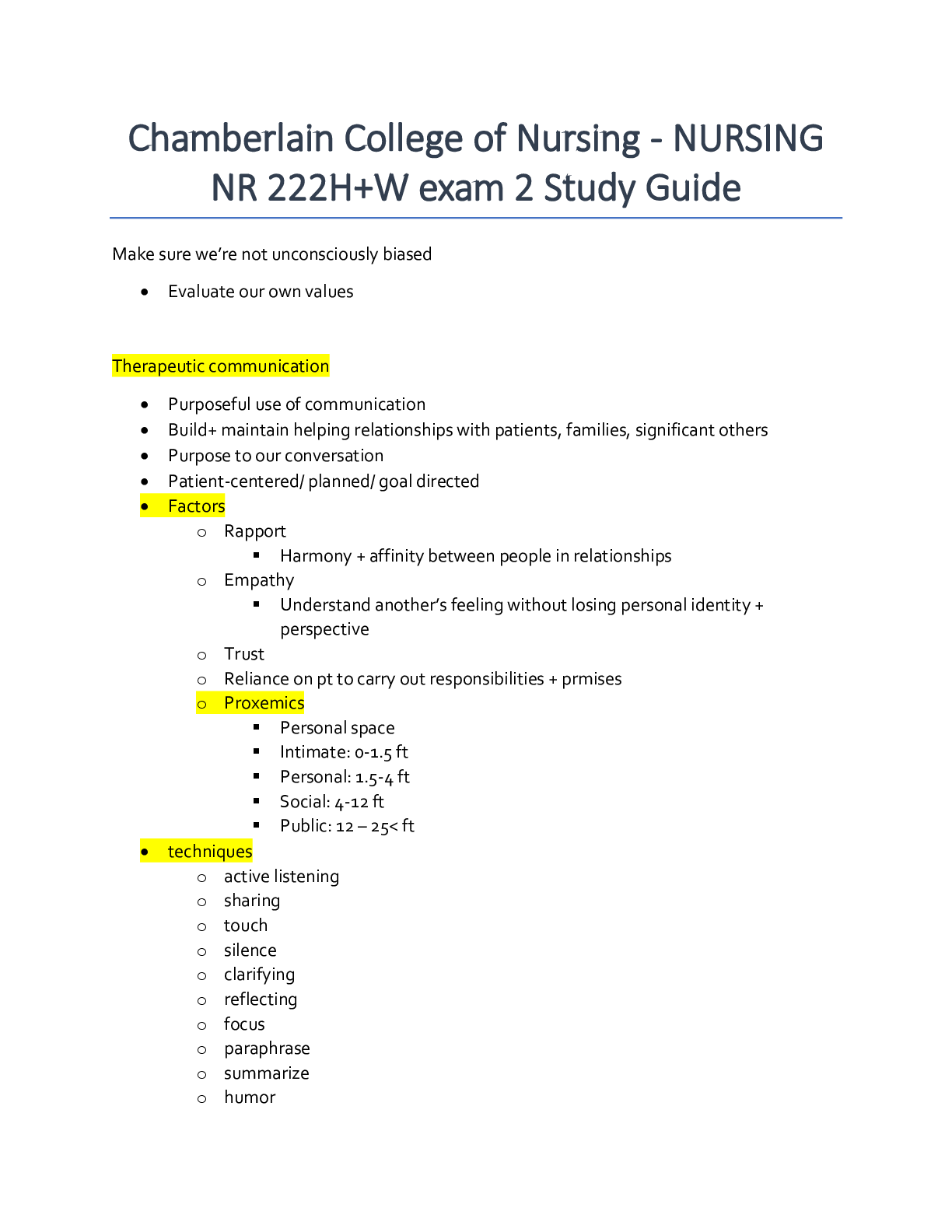Health Care > QUESTIONS & ANSWERS > ATI Care of the Critically Ill Patient Chapter 2 Perrin Understanding the Essentials of Critical Car (All)
ATI Care of the Critically Ill Patient Chapter 2 Perrin Understanding the Essentials of Critical Care Nursing, Chamberlain College of Nursing NR 341 (A Graded) Latest Questions and Complete Solutions
Document Content and Description Below
ATI Care of the Critically Ill Patient: Chapter 2: Perrin: Understanding the Essentials of Critical Care Nursing, Chamberlain College of Nursing NR 341 (A Graded) Latest Questions and Complete Solutio... ns Perrin: Understanding the Essentials of Critical Care Nursing Chapter 2: Care of the Critically Ill Patient MULTIPLE CHOICE. Choose the one alternative that best completes the statement or answers the ques 1) "Resiliency" in the American Association of Crit-iCcalre Nurses synergy model refers to a person's: A) Motivation to reduce anxiety through positive -steallfk. B) Ability to bounce back quickly after an insult. C) Physical strength to endure extreme physical stressors. D) Ability to return to a state of equilibrium. Answer: B Explanation: A) The correct definition of "resiliency" is the ability to bounce back quickly after an insult. The degree of resiliency is placed along a continuum between being unable to mount a response to having strong reserves. Other characteristics of this model include: vulnerability, stability, complexity, predictability, resource availability, participation in care, and participation in decision making. #1 and #3 do not define resiliency and are no related to the synergy model patient characteristics. #4, "stability," is defined as the ability to return to a state of equilibrium and range between unresponsive to therapies and at high risk for death to stable and responsive to therapy. Nursing Process: Planning Cognitive Level: Comprehension Category of Need: Safe, Effective Care Environment–Management of Care B) The correct definition of "resiliency" is the ability to bounce back quickly after an insult. The degree of resiliency is placed along a continuum between being unable to mount a response to having strong reserves. Other characteristics of this model include: vulnerability, stability, complexity, predictability, resource availability, participation in care, and participation in decision making. #1 and #3 do not define resiliency and are no related to the synergy model patient characteristics. #4, "stability," is defined as the ability to return to a state of equilibrium and range between unresponsive to therapies and at high risk for death to stable and responsive to therapy. Nursing Process: Planning Cognitive Level: Comprehension Category of Need: Safe, Effective Care Environment–Management of Care C) The correct definition of "resiliency" is the ability to bounce back quickly after an insult. The degree of resiliency is placed along a continuum between being unable to mount a response to having strong reserves. Other characteristics of this model include: vulnerability, stability, complexity, predictability, resource availability, participation in care, and participation in decision making. #1 and #3 do not define resiliency and are no related to the synergy model patient characteristics. #4, "stability," is defined as the ability to return to a state of equilibrium and range between unresponsive to therapies and at high risk for death to stable and responsive to therapy. Nursing Process: Planning Cognitive Level: Comprehension Category of Need: Safe, Effective Care Environment–Management of Care D) The correct definition of "resiliency" is the ability to bounce back quickly after an insult. The degree of resiliency is placed along a continuum between being unable to mount a response to having strong reserves. Other characteristics of this model include: vulnerability, stability, complexity, predictability, resource availability, participation in care, and participation in decision making. #1 and #3 do not define resiliency and are no related to the synergy model patient characteristics. #4, "stability," is defined as the ability to return to a state of equilibrium and range between unresponsive to therapies and at high risk for death to stable and responsive to therapy. Nursing Process: Planning Cognitive Level: Comprehension Category of Need: Safe, Effective Care Environment–Management of Care 2) Which of the following is the AACN's synergy model patient characteristic described as "the intricate entanglement of two or more systems"? A) Complexity B) Predictability C) Participation in care D) Resource availability Answer: A Explanation: A) #2, #3, and #4 are other terms used in the synergy model. Nursing Process: Planning Cognitive Level: Comprehension Category of Need: Psychosocial Integrity B) #2, #3, and #4 are other terms used in the synergy model. Nursing Process: Planning Cognitive Level: Comprehension Category of Need: Psychosocial Integrity C) #2, #3, and #4 are other terms used in the synergy model. Nursing Process: Planning Cognitive Level: Comprehension Category of Need: Psychosocial Integrity D) #2, #3, and #4 are other terms used in the synergy model. Nursing Process: Planning Cognitive Level: Comprehension Category of Need: Psychosocial Integrity 3) Which of the following stressors is one of the primary concerns of critically ill patients and should therefore be included routinely in patient assessments? A) Inability to control elimination B) Lack of family support C) Hunger D) Altered ability to communicate Answer: D Explanation: A) Other items included in Cornock's categories are: being thirsty, having tubes in the mouth and nose, being restricted by tubes/lines, being unable to sleep, and not being able to control themselves. #1, #2, and #3 are incorrect. Although the inability to contro elimination is similar to not being able to control one's self, the interpretation by Cornoc does not include this aspect as a stressor. Lack of family support and hunger were not identified as stressors by his research. Nursing Process: Assessment Cognitive Level: Application Category of Need: Psychosocial Integrity B) Other items included in Cornock's categories are: being thirsty, having tubes in the mouth and nose, being restricted by tubes/lines, being unable to sleep, and not being able to control themselves. #1, #2, and #3 are incorrect. Although the inability to contro elimination is similar to not being able to control one's self, the interpretation by Cornoc does not include this aspect as a stressor. Lack of family support and hunger were not identified as stressors by his research. Nursing Process: Assessment Cognitive Level: Application Category of Need: Psychosocial Integrity C) Other items included in Cornock's categories are: being thirsty, having tubes in the mouth and nose, being restricted by tubes/lines, being unable to sleep, and not being able to control themselves. #1, #2, and #3 are incorrect. Although the inability to contro elimination is similar to not being able to control one's self, the interpretation by Cornoc does not include this aspect as a stressor. Lack of family support and hunger were not identified as stressors by his research. Nursing Process: Assessment Cognitive Level: Application Category of Need: Psychosocial Integrity D) Other items included in Cornock's categories are: being thirsty, having tubes in the mouth and nose, being restricted by tubes/lines, being unable to sleep, and not being able to control themselves. #1, #2, and #3 are incorrect. Although the inability to contro elimination is similar to not being able to control one's self, the interpretation by Cornoc does not include this aspect as a stressor. Lack of family support and hunger were not identified as stressors by his research. Nursing Process: Assessment Cognitive Level: Application Category of Need: Psychosocial Integrity [Show More]
Last updated: 2 years ago
Preview 1 out of 55 pages
 Latest Questions and Complete Solutions.png)
Buy this document to get the full access instantly
Instant Download Access after purchase
Buy NowInstant download
We Accept:

Reviews( 0 )
$16.00
Can't find what you want? Try our AI powered Search
Document information
Connected school, study & course
About the document
Uploaded On
May 22, 2021
Number of pages
55
Written in
Additional information
This document has been written for:
Uploaded
May 22, 2021
Downloads
0
Views
86


 Questions and Answers (latest Update), All Correct, Download to Score A.png)






, (A Grade), Questions and Answers, All Correct Study Guide, Download to Score A.png)
, Questions and Answers, All Correct Study Guide, Download to Score A.png)
, Latest Questions and Answers with Explanations, All Correct Study Guide, Download to Score A.png)













